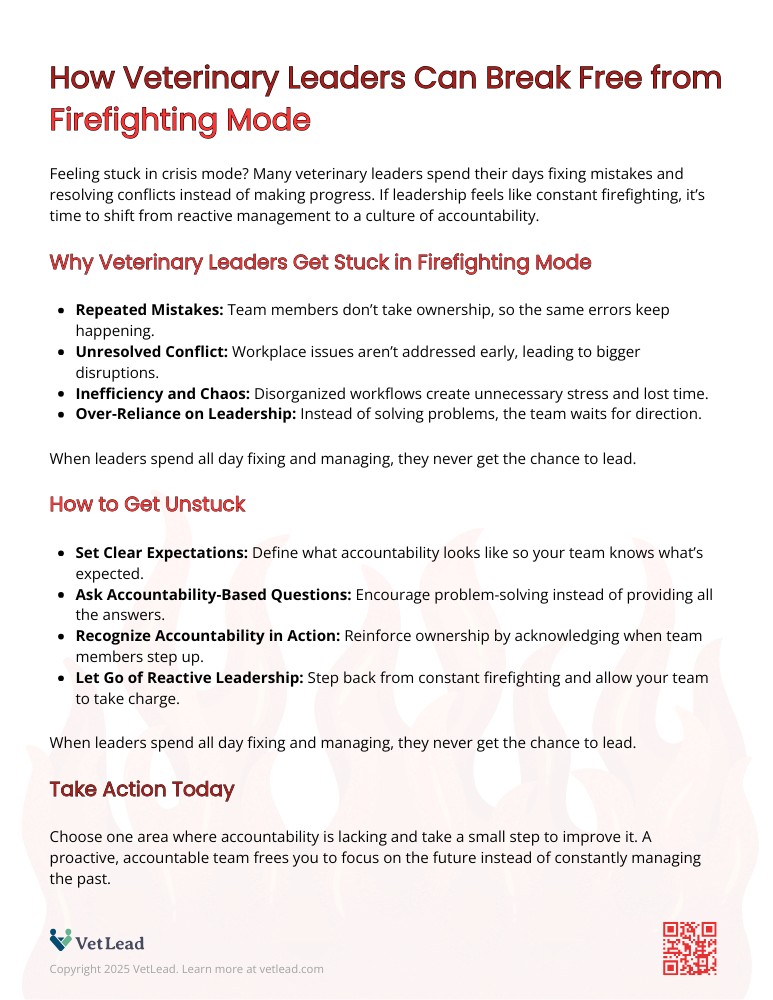If you’re constantly solving problems, stepping into team conflicts, and fixing mistakes, you’re not really leading—you’re firefighting.
Without accountability in your practice, every issue becomes your responsibility, leaving you stuck in reactive mode instead of moving your veterinary team forward. But when your team takes ownership, you can finally focus on the future instead of putting out fires.
The real problem isn’t the number of patients or the demands of client care—it’s the lack of accountability, which leads to inefficiency, conflict, and preventable mistakes. A fully accountable team doesn’t rely on leadership to solve every issue; they own their responsibilities, anticipate challenges, and take action before problems escalate.
Accountability Reduces Stress in Your Veterinary Practice
When accountability is part of your culture, you stop putting out fires all day and gain the ability to focus on long-term improvements. Let’s explore how accountability reduces stress, creates efficiency, and allows leaders to build a better future for their teams.
Why Veterinary Leaders Feel Stuck in Firefighting Mode
Veterinary leaders often handle problems that should have been solved before reaching them. Instead of guiding their team toward improvement, they get caught in a cycle of reactivity:
- Repeated mistakes happen when no one takes ownership.
- Unresolved conflicts grow into bigger issues.
- Disorganized workflows add stress.
When a leader spends every day jumping from one crisis to another, there’s no time to think ahead. The day ends, and instead of feeling like progress was made, it feels like all you did was survive.
Reactive leadership is exhausting and unsustainable. But accountability changes everything.
The Role of Accountability in Reducing Stress and Burnout in Your Practice

Accountability isn’t about punishment or micromanagement—it’s about creating a team that solves problems before they become emergencies.
Without accountability, team members pass blame, leaders waste time correcting mistakes, and frustration builds as the same issues repeat daily. But when accountability is part of the culture, problems are prevented, leaders focus on development, and workplace stress decreases.
Veterinary medicine is demanding enough—unnecessary stress from lack of accountability only makes it harder.
Accountability Gives Leaders the Ability to Focus on the Future
Constant firefighting leaves no time for growth. With accountability, leaders gain:
- Time to plan ahead. Instead of solving the same problems, they can focus on improving processes and patient care.
- Opportunities to develop their team. Coaching and mentorship become proactive rather than reactive.
- A culture of ownership. Team members learn to solve issues independently, rather than expecting leadership to intervene.
A fully accountable team allows leaders to step back and see the bigger picture. Instead of spending every day correcting, fixing, or managing inefficiencies, they can invest in training, innovation, and long-term growth.
How Positive Veterinary Culture Reinforces Accountability
New employees adopt the behaviors they see. If accountability is the norm, they follow suit. If blame and avoidance dominate, they mirror that instead.
This is why leaders must reinforce accountability daily. It’s not about what’s written in policy manuals—it’s about what’s modeled, encouraged, and reinforced in everyday interactions.
For accountability to be part of your veterinary practice’s culture, it must be:
- Visible. Team members must see accountability in action through their colleagues and leaders.
- Expected. Owning responsibilities and solving problems should be the norm, not the exception.
- Reinforced. Leaders should recognize and celebrate accountable behaviors as much as they correct mistakes.
Accountability is contagious. When high expectations are the standard, new team members naturally rise to meet them.

Download this accompanying PDF Now
Share it with leaders and teams. No email address required.
Steps to Build an Accountable Veterinary Team
Shifting from reactive to proactive leadership takes time, but small, consistent steps create lasting impact.
Define What Accountability Looks Like
Accountability only works when it’s clearly defined. Your team needs more than a vague expectation to “take ownership”—they need to know exactly what that means in your practice. Define how team members should approach problem-solving, what it looks like to step up before an issue escalates, and how they can contribute to a culture of responsibility.
When accountability is clearly defined, it removes uncertainty. Instead of wondering whether they should speak up or take action, team members will know what’s expected and feel confident doing it.
Use Accountability-Based Questions
Solving every problem yourself teaches dependence instead of critical thinking. Instead of offering immediate solutions, shift to accountability-based questions that push your team to find their own.
For example, if a mistake happens in your veterinary practice, instead of saying, “Why does this keep happening?”—which invites blame—try, “What do you think caused this, and how can we prevent it next time?” This small change keeps the conversation solution-focused and encourages proactive thinking.
When leaders consistently ask questions that encourage problem-solving, team members start anticipating solutions instead of waiting for direction. Over time, this builds confidence and reinforces accountability as a habit.
Reinforce Accountability Through Feedback

Most leaders are quick to correct mistakes, but how often do they recognize when someone takes ownership? If the only time accountability is discussed is when things go wrong, team members will associate it with punishment rather than progress.
Start catching people doing things right. If someone handles a difficult client on their own, acknowledge it: “I saw how you de-escalated that situation. That was great problem-solving.” If a technician notices an inefficiency and suggests a fix, reinforce that behavior: “Thanks for stepping up and improving that process—it made a real difference today.”
Recognition, not just correction, reinforces accountability. When efforts are acknowledged, team members keep contributing.
Leading with Accountability Instead of Stress
Leaders can either firefight daily or build a proactive team.
A culture of accountability reduces leader stress and fosters practice growth. If you feel stuck constantly managing problems, ask yourself:
- Are my team members taking ownership, or are they relying on me for solutions?
- Am I modeling accountability, or am I unintentionally reinforcing reactivity?
- What small change can I make today to shift toward a culture of responsibility?
When accountability becomes part of every interaction, every decision, and every expectation, leaders finally gain the ability to focus on the future rather than just surviving the present.
Take the Next Step
Start small. Identify one area where accountability could improve efficiency and focus on that. Use accountability-based questions to encourage problem-solving rather than reactive leadership. And don’t just correct mistakes—recognize accountability in action.
Leaders who prioritize accountability create teams that take ownership, solve problems, and build a stronger future.
